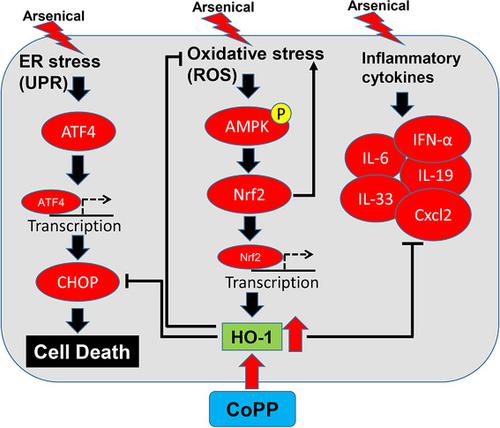当前位置:
X-MOL 学术
›
Ann. N. Y. Acad. Sci.
›
论文详情
Our official English website, www.x-mol.net, welcomes your
feedback! (Note: you will need to create a separate account there.)
Protective role of HO‐1 against acute kidney injury caused by cutaneous exposure to arsenicals
Annals of the New York Academy of Sciences ( IF 4.1 ) Pub Date : 2020-09-03 , DOI: 10.1111/nyas.14475 Ritesh K Srivastava 1 , Suhail Muzaffar 1 , Jasim Khan 1 , Amie M Traylor 2 , Jaroslaw W Zmijewski 2 , Lisa M Curtis 2 , James F George 3 , Aftab Ahmad 4 , Veena B Antony 2 , Anupam Agarwal 2, 5 , Mohammad Athar 1
Annals of the New York Academy of Sciences ( IF 4.1 ) Pub Date : 2020-09-03 , DOI: 10.1111/nyas.14475 Ritesh K Srivastava 1 , Suhail Muzaffar 1 , Jasim Khan 1 , Amie M Traylor 2 , Jaroslaw W Zmijewski 2 , Lisa M Curtis 2 , James F George 3 , Aftab Ahmad 4 , Veena B Antony 2 , Anupam Agarwal 2, 5 , Mohammad Athar 1
Affiliation

|
Lewisite and many other similar arsenicals are warfare vesicants developed and weaponized for use in World Wars I and II. These chemicals, when exposed to the skin and other epithelial tissues, cause rapid severe inflammation and systemic damage. Here, we show that topically applied arsenicals in a murine model produce significant acute kidney injury (AKI), as determined by an increase in the AKI biomarkers NGAL and KIM‐1. An increase in reactive oxygen species and ER stress proteins, such as ATF4 and CHOP, correlated with the induction of these AKI biomarkers. Also, TUNEL staining of CHOP‐positive renal tubular cells suggests CHOP mediates apoptosis in these cells. A systemic inflammatory response characterized by a significant elevation in inflammatory mediators, such as IL‐6, IFN‐α, and COX‐2, in the kidney could be the underlying cause of AKI. The mechanism of arsenical‐mediated inflammation involves activation of AMPK/Nrf2 signaling pathways, which regulate heme oxygenase‐1 (HO‐1). Indeed, HO‐1 induction with cobalt protoporphyrin (CoPP) treatment in arsenical‐treated HEK293 cells afforded cytoprotection by attenuating CHOP‐associated apoptosis and cytokine mRNA levels. These results demonstrate that topical exposure to arsenicals causes AKI and that HO‐1 activation may serve a protective role in this setting.
中文翻译:

HO-1对皮肤砷暴露引起的急性肾损伤的保护作用
路易赛特和许多其他类似的军火是为在第一次世界大战和第二次世界大战中使用而开发和武器化的战争起泡剂。这些化学物质当暴露于皮肤和其他上皮组织时,会引起快速严重的炎症和全身损伤。在这里,我们表明,在小鼠模型中局部应用砷会产生严重的急性肾损伤(AKI),这可以通过 AKI 生物标志物 NGAL 和 KIM-1 的增加来确定。活性氧和 ER 应激蛋白(例如 ATF4 和 CHOP)的增加与这些 AKI 生物标志物的诱导相关。此外,CHOP 阳性肾小管细胞的 TUNEL 染色表明 CHOP 介导这些细胞的凋亡。以肾脏中炎症介质(如 IL-6、IFN-α 和 COX-2)显着升高为特征的全身炎症反应可能是 AKI 的根本原因。砷介导的炎症机制涉及 AMPK/Nrf2 信号通路的激活,该通路调节血红素加氧酶-1 (HO-1)。事实上,在砷处理的 HEK293 细胞中,用钴原卟啉 (CoPP) 诱导 HO-1 可通过减弱 CHOP 相关细胞凋亡和细胞因子 mRNA 水平来提供细胞保护。这些结果表明,局部接触砷会导致 AKI,而 HO-1 激活可能在这种情况下发挥保护作用。
更新日期:2020-09-03
中文翻译:

HO-1对皮肤砷暴露引起的急性肾损伤的保护作用
路易赛特和许多其他类似的军火是为在第一次世界大战和第二次世界大战中使用而开发和武器化的战争起泡剂。这些化学物质当暴露于皮肤和其他上皮组织时,会引起快速严重的炎症和全身损伤。在这里,我们表明,在小鼠模型中局部应用砷会产生严重的急性肾损伤(AKI),这可以通过 AKI 生物标志物 NGAL 和 KIM-1 的增加来确定。活性氧和 ER 应激蛋白(例如 ATF4 和 CHOP)的增加与这些 AKI 生物标志物的诱导相关。此外,CHOP 阳性肾小管细胞的 TUNEL 染色表明 CHOP 介导这些细胞的凋亡。以肾脏中炎症介质(如 IL-6、IFN-α 和 COX-2)显着升高为特征的全身炎症反应可能是 AKI 的根本原因。砷介导的炎症机制涉及 AMPK/Nrf2 信号通路的激活,该通路调节血红素加氧酶-1 (HO-1)。事实上,在砷处理的 HEK293 细胞中,用钴原卟啉 (CoPP) 诱导 HO-1 可通过减弱 CHOP 相关细胞凋亡和细胞因子 mRNA 水平来提供细胞保护。这些结果表明,局部接触砷会导致 AKI,而 HO-1 激活可能在这种情况下发挥保护作用。











































 京公网安备 11010802027423号
京公网安备 11010802027423号